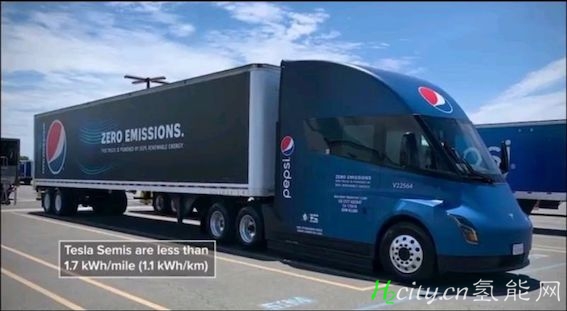Michael Sura:
I published a post comparing the energy consumption of a Tesla Semi and an average diesel truck. Many of you have asked if the Tesla Semi defies the laws of physics by achieving such low power consumption figures even at full load. So I decided to play with numbers a bit and especially with physics.
Many of you have asked if the Tesla Semi defies the laws of physics by achieving such low power consumption figures even at full load. So I decided to play with numbers a bit and especially with physics.
Ftract = Frr + Fair
The rolling resistance
Frr = m * g * Crr
Where m is the vehicle mass of Tesla Semi (40000 kg), g is acceleration constant (9.81), and Crr is the rolling resistance coefficient, which would achieve a value 0.0044 (see here https://lnkd.in/eDjyW6HF) when it is supposed that the best-in-class pneu are used by Tesla.
Frr = m * g * Crr = 40000*9.81*0.0044=1727 N
The aerodynamic resistance Fair can be expressed by a formula
Fair = 0.5 * ρair * v^2 * Af * Cd
Where ρair is the density of air, v is the Tesla Semi’s speed, Af is its projected frontal area of Tesla Semi, and Cd is the coefficient of drag of Tesla Semi.
Ρair is 1.204 kg/m3 , v = 27.78 m/s (100 km/h), Af was estimated to be 9 m2 according to https://lnkd.in/eTYNaU5A, Cd - Tesla claims that the drag coefficient of Tesla Semi is 0.36 https://lnkd.in/eJ2NASZX
Fair = 0.5 * ρair * v^2 * Af * Cd = 0.5*1.204*(27.78)^2*9*0.36=1505 N
Ftract = Frr + Fair = 1727 + 1505 = 3323 N
The amount of force Ptract required to move the wheels Tesla Semi would be:
Ptract = Ftract * v = 3232 N * 27.78m/s = 89.785 kWh
We assume that Tesla Semi’s pack-to-wheel efficiency is 95% because there are used superefficient IPM-SynRMs (electric motors), SiC inverters, etc.
The resulting energy consumption Ekm per km would be
Ekm = (Ptract /0.95)/100=0.945 kWh/km
As I mentioned above, this is the simplified calculation of energy consumption, for example, acceleration resistances, which depend on driving style, were not taken into account. Consumption is also affected by the force of the wind, rain, road conditions, etc.
My calculation showed that the 1.06 kWh/km consumption achieved by a fully loaded Tesla Semi is achievable.、
 Semi's efficiency is 1.1 kWh/km or 1.7 kWh /mile according to the people at Pepsi.
Semi's efficiency is 1.1 kWh/km or 1.7 kWh /mile according to the people at Pepsi.
平台声明:该文观点仅代表作者本人,零碳未来网 系信息发布平台,我们仅提供信息存储空间服务。








发表评论 取消回复